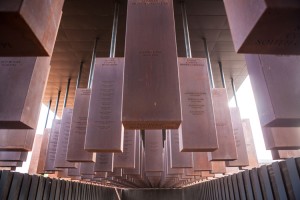A Chilling History of Racism
Thursday, May 24th, 2018May 24, 2018
Last month, on April 26, the new National Memorial for Peace and Justice opened along with the new Legacy Museum in Montgomery, Alabama. The sobering memorial and museum—separate places built to complement each other—are dedicated to the legacy of enslaved black people, people terrorized by lynching, and the injustice of dealing with racial segregation and discriminatory laws. They also detail the current burdens of African Americans facing unfair presumptions of guilt and excessive police violence.

The hanging memorials within the National Memorial for Peace and Justice detail the chilling history of the lynching of African Americans in the United States. Credit: Sonia Kapadia (licensed under CC BY-SA 4.0)
The memorial and museum were created by the Equal Justice Initiative (EJI), an organization committed to ending mass incarceration and excessive punishment in the United States, challenging racial and economic injustice, and protecting basic human rights for the most vulnerable people in American society. Work on the memorial began in 2010 as EJI staff began investigating the history of lynchings in the American South. The numbers they came up with were staggering: more than 4,400 black people were lynched in the United States between 1877 and 1950.
Covering 6 acres (2.4 hectares), the Memorial for Peace and Justice details America’s history of racial inequality with unflinching glimpses of racial terror. The site includes sculptures and a central square with 800 hanging monuments that symbolize the brutal deaths of lynching victims. Each monument is peculiar to a county and state where lynchings took place, and each lists the names (when available) of victims and the dates when they were killed.
The memorial includes exhibits on the civil rights movement in the United States, with special attention paid to the local Montgomery bus boycotts of the 1950′s. Other exhibits deal with the contemporary issues of police violence and racial bias in the criminal justice system. The memorial displays writing from author Toni Morrison, words from civil rights icon Martin Luther King, Jr., and a reflection space in honor of journalist and reformer Ida B. Wells-Barnett.
A short walk away in Montgomery, the Legacy Museum: From Enslavement to Mass Incarceration is built on the site of a former warehouse where enslaved black people were held before being bought and sold at a nearby auction site. Montgomery was once an important center of the slave trade in the American South, and many sites in the city chronicle this unfortunate history. Like the memorial, the 11,000-square-foot (1,022-square meter) museum details the chilling history of racism in the United States. First-person accounts tell the reality of living through the slave trade, and research materials and multimedia provide sobering details. The Legacy Museum also has exhibits on lynching, segregation, and the mass incarceration of African Americans.


